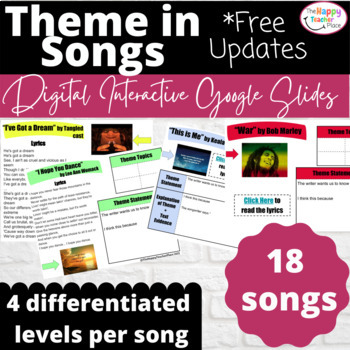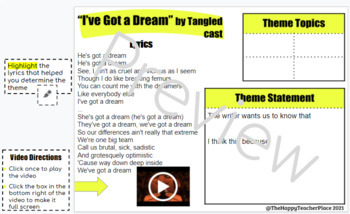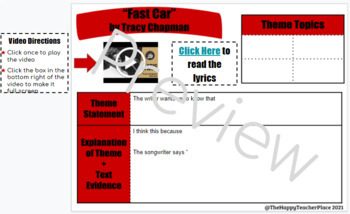Teach Theme/Moral/Lesson with Songs & Lyrics {Digital Interactive Google Slides}
- Google Slides™

What educators are saying
Description
Hi teacher friends!
Are you looking for a fun way to introduce and practice the skill of finding theme? This is the only resource you will need for teaching theme/ moral/ lesson with songs! I found myself struggling with how to introduce theme to my students, but then I came up with the idea of using songs and their lyrics. I created this product for use in my own classroom, and when I used it, my students were hooked! They were engaged and motivated - singing along in the classroom, listening closely to the lyrics, and after modeling and practicing with a few songs, they were all able to demonstrate an understanding of theme using these digital worksheets!
My students are at all different levels, and I need to DIFFERENTIATE, which is why each song in this resource has 4 different levels of worksheets*:
- Song and lyric excerpt (around 2 min) with multiple choice theme statement options
- Song and lyric excerpt (around 2 min) with open ended theme topic and theme statement
- Full song and copy of lyrics with open ended theme topic and theme statement
- Full song and copy of lyrics with open ended theme topic, theme statement, and explanation of theme/ text evidence.
*Only give each student 1 of the versions per song. When I used this in my classroom, I had students all using the same song, but working at different levels of complexity, which is why I created the multiple levels!
Suggestions:
- Use this resource as an introduction to teaching theme and/or citing evidence for theme.
- Pick one song in this resource to use as a teacher model. Show how to “close read” lyrics to determine theme.Then, have students work together or individually on a different song in this resource to determine theme
- Use as classwork, checkpoints, warm-up or exit-slip, or assessments
Songs included:
- “This is Me” by Keala Settle
- “You’ve Got a Friend in Me” by Randy Newman
- “Hall of Fame” by The Script
- “Colors of the Wind” by Judy Kuhn
- “The Climb” by Miley Cyrus
- “Let it Go” by Idina Menzel
- "I've Got a Dream” by Tangled cast
- “I Hope you Dance” by Lee Ann Womack
- “Flashlight” by Jessie J
- “The Middle” by Jimmy Eat World
- “Fast Car by Tracy Chapman
- “The Best Day” by George Strait
- “The Anthem” by Good Charlotte
- “Life is a Highway” by Rascal Flatts
- “No Such Thing” by John Mayer
- “Born This Way by Lady Gaga
- “Help!” by The Beatles
- “War” by Bob Marley
***This product purchase comes with free updates. If there is a song not included that you would like to be added, please comment or send me a message and I will update!***





